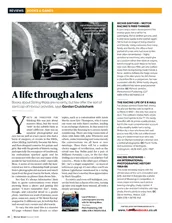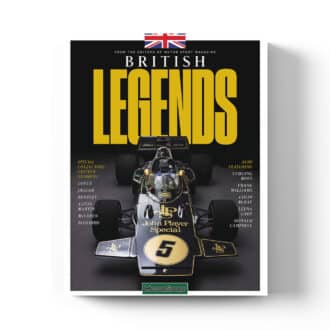
Book Review: Lap of Honour — a photographic journey with Sir Stirling Moss
You’d be forgiven for thinking this was just about maestro Moss, but the word ‘with’ in the subtitle hints at what’s different. Hain was an amateur photographer and race fan…
THE SPORT A 1AT
PREPARING FOR THI-4, SI-JASON
By the Hon. VICTOR BRUCE
WITH the glint of ice on roadside ponds, or the threat of snow in the sky, it may cause a mental shudder to think of speed-boating and possible duckings for the inexpert or unwary—but the season is apt to creep upon one unexpectedly, and for those who are proposing to indulge in the pastime of water motoring this year it is a safe maxim that they cannot begin their preparations too early.
Whether the boat to be used is an old friend of the preceding season, a new one still to be purchased, or a second-hand craft picked up as a bargain, delay in taking the necessary steps to put it into commission is likely to involve disappointment or a loss of enjoyment during the early part of the short season. So far as new boats are concerned, there is every reason to believe that the developments of the past few years will reach fruition this season in a considerably augmented demand.
Enormous progress has been made in the design of both power units and hulls, and it is my belief that even the more or less uninitiated public now accepts the inexpensive outboard-engined hydroplane as a perfectly practical craft, which, in conjunction with a motorcar, will give complementary, or even alternative, pleasure.
There is very little doubt, in my mind at least, that the spade work of the pioneers will this year begin to bear fruit. Whether the British motorboat industry is fully prepared for a ” boom ” remains to be seen, but those who are already converted to the new pastime will be wise not to be too optimistic on this score. In other words, they should already be seeing about purchasing their new boats.
Incidentally the question of second-hand craft is almost equally affected, since a shortage in the supply of new boats, in answer to the suddenly increased demand which I foresee, is bound to cause an inflation of prices.
For those who are now taking to motorboating for the first time, the question of the type of craft with which to start is rather difficult. Since we have very largely to thank the American industry for the fact that the new form of motorboating is possible at all, it would be ungrateful to decry the products emanating from the other side of the Atlantic.
But we need scarcely explain the basic advantages of acting on the slogan, “Buy British.” It is sufficient to say that patriotism in this respect in regard to motorboats, equally with motorcars, entails no practical sacrifice. The reverse, in fact, is emphatically the case ; and if the promised boom materialises, the advantage in regard to quicker and more efficient service for the British motor boat will be even more important. In any case, it is my considered opinion that in regard to performance, as well as from the investment point of view, ” buying British” is the best policy.
In regard to the selection of a particular type of boat, for full satisfaction it is just as important to be quite clear as to the kind of performance that is required as it is in buying a motor car. Just as with the car it is possible to obtain anything from a 100 mile-an-hour sports car down to a modest family five-seater costing one-tenth of the price, so every conceivable variety of requirement is catered for in the motor boating world. Obviously, a racing hydroplane would be as unsuitable for the man who only wants to picnic in shady backwaters in the upper reaches of the Thames, as would, on the score of cost of maintenance, be a 100 h.p. cruiser, no matter how cheaply purchased second-hand, for the purchaser to whom the petrol bill is a serious matter.
The best possible advice that one can give on the matter of selection, therefore, is that further advice should be sought ! I personally shall be very willing to give any help within my power to any correspondent who cares to submit his problems to me, but in any case I do want to emphasise the necessity for a very careful consideration of exact requirements before a purchase is actually made. Although we are supposed to be a maritime nation, I suppose that the percentage of inhabitants of these Isles who know, anything about water motoring ” rules of the road” and general etiquette is very small ; and and this fact is probably the greatest deterrent to a wide demand that the industry has to face. While one cannot belittle the importance of knowledge of rules and regulations and customs, this knowledge is not difficult to acquire, and so far as the actual management
of the boat is concerned, it is a whole lot easier than the driving of a motor car. As a matter of fact, the two processes are identical in most respects, and it is the fashion nowadays to make the controls, steering, instrument board and so on almost indistinguishable from those of a car.
The driving of a comfortable four-seated boat capable of twenty odd miles an hour is actually child’s play, while the piloting of a racing hydroplane capable of exceeding forty miles an hour is certainly no more difficult than the task of extracting the best possible performance from a fast sports model on the road.



